Update February 2025 – Post Ethereum Merge – ASIC vs GPU revisited
With the ETH merge well in the rearview mirror, I thought it might be a good time to revisit the topic of whether to choose ASICs vs GPUs for crypto mining. So much has changed since our last update: many PoW coins have launched, gained, and lost traction, and various ASIC manufacturers have gained market share from the dominant Bitmain, albeit at the margins. Any updates to this article will be marked with 2025 in the paragraph.
TL:DR; For most people, unless you’re going industrial scale, heating your garage or have free electricity – cryptomining is best pursued as a hobby or passion project – not for profit. That said…
Choose ASICs if:
- You have access to very cheap electricity & infrastructure
- You can get in early with new hardware
- You’re willing to take bigger risks for potentially higher short-term rewards
- You’re focused on bitcoin
Choose GPUs if:
- You want to experiment, start small and scale gradually
- You prefer a more DIY & flexible approach
- You want the ability to pivot between different coins and uses, like AI inference
- You’re concerned about hardware resale value
Update May 2022 – Ethereum Merge (transition to Proof of Stake)
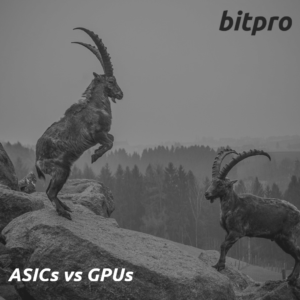
Update May 2022 – Currently, Ethereum mining accounts for 97% of mining revenue for GPU miners (even if you’re using Nicehash and getting paid in Bitcoin, your hardware is almost certainly mining Ethereum). The Ethereum development team is planning to transition to proof of stake in an event known as the merge in the very near term. The future of Ethereum mining on either GPUs or ASICs is very uncertain. Before making an investment into any Ethereum mining hardware – make sure you understand the risks of the Proof of Stake transition, as, at the time of writing there is no high-paying alternative coin to mine that can sustain profitability when millions of GPUs are no longer able to mine Ethereum.
Get up to speed on this impending change affecting all GPU miners start with our recent article on GPU prices, follow it up with how it’s going so far in 2022, and finally dive deep to understand GPU mining profitability after Eth 2.0.
Update August, 2021 – Mining Data & Chart Refresh
Several years have passed since this article was originally written. Very little in terms of content has changed, as the original points still stand strong. Primarily, out of date charts and figures were updated to reflect current data.
ASIC vs GPUs: At First Glance
In almost every interaction I have with a new client, ASICs are inevitably one of the first mining rig hardware options discussed. Understandably so, as the value proposition is so straightforward. ASICS are purpose-built to do one thing and one thing only: mine a specific crypto, and mine it fast. Nothing else can compete with an ASIC on that front. Whereas GPUs are general-purpose processors that can calculate anything. They’re particularly good at graphics and cryptocurrency mining, but the important takeaway is that they can calculate anything. Even though we’re talking about mining, their flexibility is far more important than you might realize.
At first glance, ASICs have a lot going for them. A GPU can’t compete with an ASIC in terms of raw hashpower or efficiency. ASICs are dead simple to use – literally plug and play: there are USB ASIC miners. There’s no other way to mine Bitcoin directly, and that’s the most stable crypto by far. A single ASIC is even less expensive than a full GPU rig. More powerful, more efficient, more stable, easy to use, and cheap. Conversation over, right? Not so fast…let’s dig in a little deeper here. It’s counter-intuitive, but for virtually anyone reading this, ASICs are the worst deal in cryptocurrency mining hardware and arguably in all of crypto. Let’s examine how ASICs and GPUs truly stack up on all of these supposed advantages.
ASIC vs GPU: Hash Power
ASICs – Hands down more powerful – in terms of hash rate. But are you mining hashes, or are you mining crypto? This is an incredibly important distinction.
An ASIC is not a printing press for crypto, where the speed of the machine directly determines how much crypto it can mint. That’s just not how crypto works. The amount of new currency generated with each block is a fixed amount. For Bitcoin, it’s 3.125 new BTC every ten minutes, no more, no less. Your share of that reward is directly proportional not to your hash rate, but to your fraction of the total network hashrate. You’re buying the same ASICs everyone else is. Which means on a per unit basis you’re all on a level playing field, so you can completely factor the hashrate out of the equation. The power of the ASICs themselves are completely irrelevant. When it comes to the amount of crypto you’ll earn, the only differentiator between you and everyone else is how many ASICs you have. Unless you have an older, less efficient model – in that case, you and your old and busted ASIC are what’s irrelevant now, because you can’t compete anymore.
GPUs – Sure, they can’t beat ASICs at their own game. But they’re not playing the same game. They can mine every crypto and also do a lot of useful things that ASICs can’t do.
In the early days of crypto, there was a short period when ASICs had pretty much buried GPUs. But as crypto is a grassroots movement, it didn’t take long for people to come up with new PoW algorithms that were difficult to create ASICs for. Even when ASICs did come out for them, they were either barely more efficient than GPUs (Ethereum), or most cryptos changed their software to make the ASICs useless (Cryptonight, Equihash). New ASIC-resistant algorithms and coins are coming out all the time. Put simply, if ASICs were going to completely kill GPUs, they already would have. The fact that they didn’t is proof that they won’t. It’s a cat and mouse game, and the cat will never catch all the mice. Sometimes it feels like a losing battle, but those mice aren’t just going to roll over. There only are a handful of companies profiting from ASIC mining. Whereas there are literally thousands of companies big and small profiting from or completely dependent on GPU mining. And it runs the gamut from gigantic publicly-owned multinational corporations like Nvidia and AMD: raking in millions of dollars on GPU sales, down to the everyday gamer with a few GPUs. The huge number of stakeholders in GPU mining will not just throw up their hands and cede the entire cryptocurrency mining market to Bitmain without a fight.
This point is demonstrated perfectly in 2021 – an older Bitmain S9 is now barely profitable, producing a net profitability of ~$1.50 on 1600W, and even that is only because of a significant hashrate drop due to China banning mining – prior to that it was sub $1. Whereas even ancient GPUs like the RX 470 4GB, which cost $200 retail 5 years ago and uses only 125W, still nets $2+/day. More significantly, it is remaining profitable despite the fact that 4GB GPUs can no longer mine Ethereum – new coins such as RVN and ERGO are highly profitable for them.
Our post-Merge observations in 2025 strongly reinforce this. ASICs gave miners the highest hashrate – e.g. an Antminer KS5 made a GPU rig look like a toy – yet when everyone got the same ASIC, the per-device earnings plummeted. This shows that the “ASIC = more profits” equation doesn’t hold up once you factor in the competitive response and importantly, the total cost of ownership of the machine. Indeed, for many, ASICs turned out to be the worst deal in mining hardware when they bought into over-saturated devices.
The thesis that ASICs quickly lose profitability due to saturation remains valid, supported by the Kaspa case and continued churn in Bitcoin mining, where only the latest ASICs are viable.
ASICs vs GPUs: Efficiency
ASICs – Sure, they’re more efficient…per hash. Again, are you mining hash, or are you mining crypto?
In 2018, many ASICs drew about 800 watts. And 800 watts on an older ASIC uses exactly as much power as 800 watts on a new ASIC. Your power bill didn’t go down when you upgraded to a more “efficient” ASIC. And since everyone else is buying the same ASICs that you are, everyone ends up in exactly the same place – burning the same watts for the same relative slice of the profits. The only real winner in this arms race is the company building the ASICs.
In 2018, when this article was initially published, it only took a GPU that burns 100W to mine $1 USD-worth of Ethereum a day, after electricity, whereas you need an 800W+ ASIC to mine $1 USD equivalent in Bitcoin a day, after electricity.
In 2021, the numbers have gotten much bigger, but the point still stands. A Bitmain s19j produces about $32 worth of BTC for an input of 3000W. Whereas 3000W of modern GPUs (23 RX 5700) will net $92 worth of ETH.
As of February 6, 2025, Bitmain’s latest Bitcoin miner is the Antminer S21E XP Hyd 3U, released in November 2024. This model offers a hashrate of 860 terahashes per second (TH/s) and consumes 11,180 watts (W) of power. At an electricity cost of $0.10 per kilowatt-hour (kWh), the Antminer S21E XP Hyd 3U generates approximately $48.86 in daily revenue, with a net daily profit of about $22.03 after accounting for electricity expenses. Compare this to 11,180W of RTX 4090s which net about $7 on Aleo at time of writing. Insert customary warning about mining calculations being out of date as soon as they’re uttered.
However, if you step outside of crypto mining, which is currently heavily competitive due to many factors, (free investor capital for large BTC PubCos, active GPU miners with operations scaled in the historical context of mining ETH for much higher rewards) you can also deploy that 4090 to run AI inference locally or rent out your hardware using a popular service like Vast.ai, which is currently paying around $0.20/hr. Renting out your GPUs comes with more stringent requirements, covered in our other article, but if you’re able to meet those requirements then GPUs are again more efficient because they’re flexible.
In dollars per watt, it used to be true that GPUs produced crypto more efficiently than ASICs. However, once ETH went offline, this no longer held true. There are simply not enough GPU-mineable PoW rewards to feed the hash rate that ETH brought online.
What these comparisons do not show is the level of infrastructure you must be prepared to engage with to run modern mining hardware.
For most small-to-medium-size miners, the first bottlenecks you inevitably bump up against are:
- the total amount of power your electrical service can deliver,
- the amount of heat your space can deal with.
A GPU rig is definitely larger than an ASIC, but physical space tends not to be the bottleneck in most cases. Once you hit the power/heat wall, it’s often a very costly upgrade to continue expanding, and you need to make some hard decisions about how to move forward. With GPUs, you will simply be able to pack more profit in before you hit that wall (this is debatable after the merge). With GPUs, you will be able to experiment with mining, with a lower barrier to entry in most cases.
ASIC vs GPU: Ease of use
ASICs – There’s no argument here, ASICs are easy to use. Even if you’ve never mined before, you hardly need someone like me to help you set up an ASIC.

But let us never forget the #1 Cardinal Rule of Mining – profitability is always inversely proportional to how easy it is to mine something. Mining is a competition. When there’s almost no barrier of entry and success is assured – when everyone is a winner, no one is a winner.
Imagine for a moment a $10 million-dollar competition, when all you need to do is show up and raise your hand to win. It costs $11 to enter, and every winner splits the prize. What happens? A million people show up, raise their hands and split the $10 million dollars a million ways, and walk away with $1 less than it cost to enter. In reality, there was only one winner – the people running the contest, because they walked away with $1 million, while everyone else was lucky to almost break even. That’s ASIC mining in a nutshell. Of course, the reality is far more complex, but the general idea stands – in mining, ease of use is not a positive, it’s a negative. It means everyone can compete with you, and if you’re actually trying to profit here, the last thing you want is a fair fight.
GPUs – There’s no doubt about it, GPUs are more difficult to mine with. But it doesn’t require a Ph.D. to put together a basic rig and plug in a USB stick with software that makes GPU mining simple.
Even so, the #1 Cardinal Rule still stands. Even if it’s not that hard, it’s still more challenging than mining with ASICs. So you’re much better off DIYing or even buying an off-the-shelf GPU rig over buying an ASIC. But Cardinal Rule #1 also applies at multiple levels – to the degree you’re making things easy when dealing with GPUs, you’re also lowering your profits. Because when you take the easy route, everyone is building the same rigs you are, buying the same GPUs you are, and mining the same Ethereum and Ravencoin that you are. It’s better than ASICs for sure, but it’s far from ideal. Given enough time you’ll probably still turn a profit. But when times get tough, it’s often not enough to stay afloat or make a satisfying return. In order to maximize your profitability with GPU mining, you need to mine the things that other people aren’t mining. Optimize in ways that no one else is talking about. Take chances on things that other people don’t even know about. If you’re up for that and have the patience for it, you can still make a profit GPU mining.
ASIC vs GPU: Price
ASICs – An ASIC is relatively inexpensive, often available <$2000 or even <$1000. (If you’ve been listening, you already know what the problem is. Cheap = low barrier to entry = no one wins but the people running the show. Cardinal Rule #1 strikes again.)

But let’s never forget Cardinal Rule #3 either. ROI = Income – Sticker Price – Electricity + Residual Value. In my opinion, this is the number-one-most-important differentiator between ASICs vs GPUs, so I’m really going to dwell on this.
An ASIC is a one trick pony – it can only mine a specific coin. If the income for that crypto exceeds the cost in electricity, there’s no reason to ever turn it off. It’s not like you can use it for anything else anyway. Every Bitcoin-mining ASIC will mine Bitcoin 24/7 until it is no longer profitable to do so, so there are no counter forces to push back against hashrate growth. Basically, an ASIC is solely a bitcoin mining machine. Whereas with GPUs, a significant amount of them come from gaming rigs that are mining in their off time or casual miners with a rig or two. When profitability gets low, gamers stop mining and casual miners sell their GPUs to gamers. Which means when the going gets tough, things get easier for the GPU miners that stick with it, because a lot of the competition simply goes away.
Things get even worse when you look at the effect this has on the secondary market. If income no longer exceeds the cost in electricity, your ASIC is worthless (to you, at least). There is simply no reason to turn on the ASIC when you’d acquire more crypto buying it on the open market than running your ASIC. Your utility from owning that ASIC is zero, as it is for the thousands of other people with the same ASIC as you. Which makes the road to ROI a much steeper climb than you might realize because profit always decreases over time and you can’t rely on resale value to prop up the other side of the equation. Resale value rapidly approaches zero as the ASIC approaches unprofitability. For people now in your situation, at least. But it gets even worse!
A subtle factor in this equation is that everyone pays a different price for electricity. Which means your resale value isn’t exactly zero, as someone with cheaper electricity can still profit from buying your ASIC. But they’re only going to pay bottom dollar for it because they know how worthless it is to you, and everyone and their mother is trying to sell their worthless ASICs to them at the same time. They have the pick of the litter so you will get pennies on the dollar. But something is better than nothing. So the vast majority will still resell their ASICs to someone with cheaper electricity instead of throwing them in the garbage or leaving them on the shelf, which means those ASICs effectively never get turned off, they just get moved around. Which means there’s no mitigating effect on hash rate for ASIC coins. The rate of growth barely even slows down when the market crashes. You don’t have to take my word for it, here’s a chart.
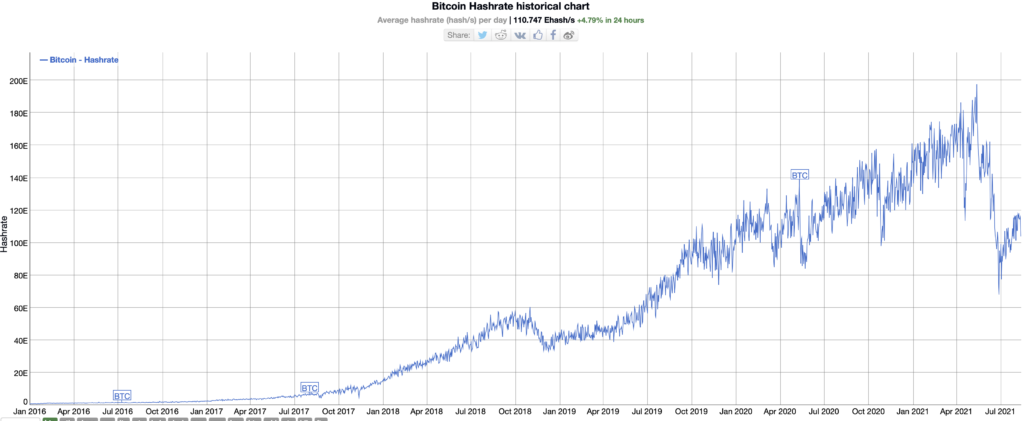
Short of a natural disaster that wipes out tons of miners at once, hashrate never goes down.
Note: In May 2021, China banned mining. So these black swan events do happen from time to time. But as noted earlier, BTC hashrate doesn’t go offline permanently, it just moves around. This equipment is rapidly being relocated elsewhere, as demonstrated by the even more rapid rise of hashrate after the drop. So this is just a short term pause that will have little net effect on the inexorable rise of hashrate.
The only way your profitability ever rises above where it was on day 1 is if the market price of bitcoin increases – but then you have to ask yourself why you bought an ASIC and not just bitcoin itself. You can do the math if you want, but I’ll spare you the effort – unless you have ultra-cheap or free electricity, in any situation where you would have profited with an ASIC, you’d have profited even more by investing into GPU mining or just buying the crypto. In any situation where you would have lost buying the ASIC, you’d have lost less by investing into GPU mining or just buying the crypto.
GPUs – GPUs are either more or less expensive depending on how you look at it. A full 6-GPU rig will cost more than your average ASIC because it’s not just a single thing, but a modular system. The foundation of the rig will run about $500-700, but each individual GPU is relatively inexpensive and you have a plethora of different choices and prices. They’re certainly less expensive to run overall, and they’re far easier to acquire and service since they’re composed of off-the-shelf computer parts.
So while it might cost you more upfront to build a single GPU rig than a single ASIC, consider the full cost of ownership for a year. How much you spend on electricity depends on how powerful your rig is, but with GPUs being more efficient on a dollar/watt basis, you will have spent relatively less on powering the GPU rig. But more importantly, how much did your hardware depreciate in value over that year? Because that is the true measure of how much the hardware cost to own – and your ASIC is going to be worth significantly less if worth anything at all, and the GPU and all of the associated parts in the rig will be worth at least half or more of what you paid for them. Overall, GPUs are a little more expensive upfront but cost less to own over time.
With crypto being such a volatile market, we can hope for the best, but still need to prepare for the worst. What happens to GPU mining when the market crashes to the point where mining is barely profitable?

It slows down. From Mid-September to November, difficulty was flat. As the market bubbled over in Dec-Jan, there was a huge influx of GPUs as profitability was through the roof. As the market continued to slide down through March, it pretty much flatlined again. In May we saw a momentary recovery, and a corresponding bump in growth, but nothing dramatic.
However, the real story is in the profitability charts.
Here’s Bitcoin. December sure was a great month, but the May bump is barely perceptible. Profitability went from a miserable 0.5 to 0.6, because throughout this entire time, ASICs never went offline and more and more kept coming online.

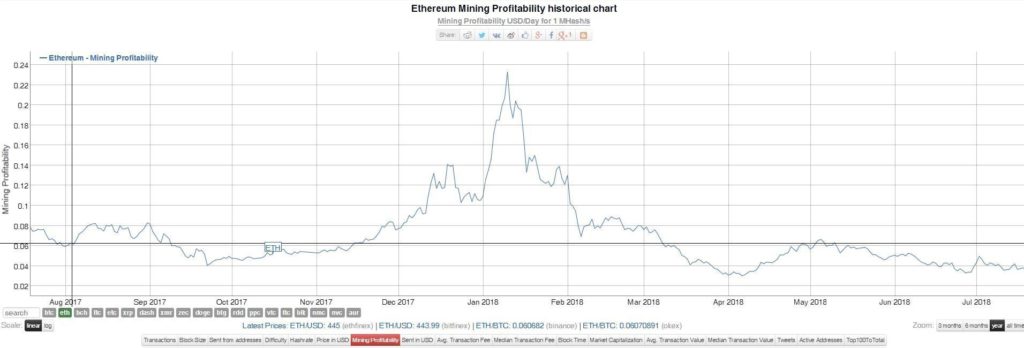
Specifically, look at April to May. 0.03 up to 0.065. Profitability more than doubled in the same time period that Bitcoin barely edged upwards. This was because at this point, so many had given up on GPU mining, leaving those who stuck with it to reap all of the rewards. Sure, it slid back down again as the market headed back down, but it’s no worse than it was in April, which is remarkable considering that the price of Ethereum is even lower now (written late 2018) than it was back then. Whereas with ASICs, profitability is down to roughly half of what it was in April, with no end to the decline in sight.
Note: I have left the original charts from 2018 intact, as the latest drop in May 2021 was unlike the early 2018 crash in that GPUs and ASICs still remain extremely profitable right after the crash, especially due to the China ban. The slowdown effect I speak of is where a market drop alone pushes mining to levels of marginal profitability, which I believe is still inevitable in the coming months/years.
ASIC vs GPU: Flexibility
ASICs – There’s nothing to really say here. They are not flexible, period. Sure, there are ASICs that can mine more than one algorithm, or more than one coin, but at the end of the day, all they will ever be able to do is the only thing they were specifically made to do.

GPUs – This is where GPUs win hands down. And it’s why GPUs will always be the better choice for small-to-medium-size miners. Never forget Cardinal Rule #9 – don’t mine what you hold, and don’t hold what you mine. Just because your 4GB GPU is ideal for RVN doesn’t mean you need to hold that RVN you mined. It’s virtually effortless to turn that RVN into BTC, lots of pools and exchanges will do it automatically for you. The fact that you’re not directly mining Bitcoin is a distinction without a difference. You run your GPUs, and you get Bitcoin in return. You may as well be mining Bitcoin: voilà, mining bitcoin is profitable. There’s no better argument against ASICs than the fact that dollar for dollar, a GPU miner who continually converted their income to BTC earned more BTC than someone who spent an equivalent amount on Bitcoin mining ASICs. Let that one sink in. The bare minimum an ASIC, a bitcoin mining device, should be able to do is mine Bitcoin better than anything else, and when it comes down to it, it gets beaten at its own game. GPUs might as well just drop the mic and walk away.
This flexibility to mine any altcoin and trade it for any other coin protects you now and in the future. What happens when an ASIC comes out that makes RVN unprofitable? You mine ERGO. What happens when an ERGO ASIC comes out? You mine something that probably doesn’t even exist yet. What happens in an alternate dimension where there’s nothing left to mine? You rent out your hardware for rendering, for AI, for data analysis, and for a whole host of other things that the world will come up with to put those GPUs to use.
In 2021, the topic on everyone’s mind is what happens to GPU mining when Ethereum switches to PoS in “6 months.” First, we need to remember that PoS was 6 months away…6 months ago. ETH developers are notoriously terrible at setting timetables, and it’s extremely unlikely to happen in 2021, and not even a sure thing for 2022. Beyond that, there will likely be another ETH PoW fork, and other coins such as RVN and ERGO are growing rapidly and likely to be able to pick up a significant amount of slack. Make no mistake, this is still a major risk that will disrupt GPU mining significantly if and/or when it happens, but everyone who has bet against ETH 2.0 and “the death of GPU mining” has always won that bet gloriously, and I believe that will continue to be the case.
In 2022 Ethereum did fork to proof of stake despite our and others’ best efforts.
In 2025, GPU flexibility remains a winning trait: The ability to switch coins or even repurpose hardware entirely was a savior for some miners post-Merge. The original argument that GPUs offer far more flexibility and retain more optionality under changing market conditions has proven true in practice. We saw miners move from ETH to ETC to other coins, sell their hardware capturing resale value (try that with an ASIC) while others moved to then to Kaspa, and to something no one saw coming at the time of the merge, to non-mining uses such as AI-inference-as-a-service. Future-proofing was a key concept – GPUs offer a more future-proof choice in an unpredictable world where the availability of flexible compute is a constraint and, hence, opportunity to provide value. That said – you were better off if you heeded the warnings we issued and prepared for The Minerdämmerung by selling your GPUs pre-merge
Given how unpredictable the last two years have been (Ethereum ending mining exactly in 2022, or Kaspa rising in 2023?), having future-proof hardware was invaluable. A miner with a fleet of RTX 3080s in 2021 might have been dismayed at Ethereum’s end, but those GPUs could still be used for other coins or sold to recover funds. Contrast that with someone who bought a fleet of ETH ASICs – their options were extremely limited in comparison. The flexibility thesis holds up well.
And at the end of the day, when your GPU is no longer useful to mine, or if you decide you want to get out of mining altogether – this flexibility is still your best friend. Assuming you didn’t buy a mining-specific GPU (which you shouldn’t), they’ll always find a home with someone who is willing to pay a significant amount for them to do what they were originally created to do – play video games. And there are literally hundreds of millions of gamers out there. They outnumber miners by a ridiculous proportion, so the market can absorb tons of them without devaluing them to worthlessness. Even more so for your memory, HDDs, PSU, CPU, motherboard, and every piece of hardware that went into your mining rig because that’s useful to anyone who builds a computer for any reason. You built your mining rig with off the shelf computer parts, and unless the world no longer needs computers – which isn’t going to happen short of a nuclear apocalypse and then we can all agree we have much bigger problems than the residual value of your mining rig – someone will buy them for a decent price.
And if you don’t want to deal with the hassle of selling your mining gear…that’s where we can step in and turn your miners into cash without you having to lift a finger.
ASIC vs GPU: Quality, Availability, and Warranty
ASICs – As a purpose-designed machine, they tend to be well built, but decidedly no-frills. With some notable exceptions, they don’t even try to make them look nice.

Availability is questionable – outside of a market rally, they’re readily available… if you’re comfortable wiring money to China, paying tons in taxes, shipping, and customs, and waiting weeks for your ASIC. I was once quoted $250 just to ship two ASICs – I could buy another GPU for that. If you’re buying a new model, expect to wait much longer while they “test” your bitcoin mining device out for several weeks while the coin is at its most profitable. Forget about credit cards or PayPal or most other typical ways of paying over the internet. Even worse, the manufacturer only barely stands behind their product – warranties are typically 90-180 days. And enjoy dealing with international shipments if you ever need service.
Worst of all, if you were planning on putting the ASIC anywhere within earshot of a human or arms-reach of a child, let me stop you right there. These things are hot, loud, and dangerous. I don’t mean louder than you’d prefer, I mean louder than any reasonable person can tolerate. The first time you hear one you will stand in awe of how such a little machine could possibly be so loud. You don’t even want to be in the same room as one of them, let alone 10 of them. And the fans on these things will cut off a finger without even slowing down. Anyone with a toddler knows they have an irresistible urge to touch everything, and an ASIC will be the last thing those little hands ever touch. For all of these reasons I almost always insist that all ASICs in proximity are temporarily turned off while I’m working on a farm. But standing in a well-ventilated room full of 500 GPUs? No problem.
GPUs – GPUs come in all shapes and sizes. Big or small, quiet or loud, hot or not – if you want it, someone makes it. And that goes for every part in the rig. Custom PC hardware is designed to be as aesthetically pleasing as a piece of computer hardware can be.
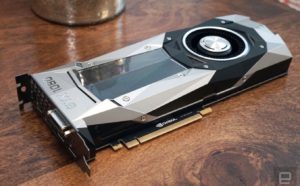
The rig will be as solidly built as you’re willing to spend on it. Cheap and rickety isn’t a bad thing if all you care about is maximizing ROI. Even so, there’s nothing here that will maim you – worst case is a boo-boo and a band-aid. GPUs are livable because they were designed to be lived with. In fact, I heat my entire house all winter with unobtrusive small rigs with near-silent water cooling. While everyone else is paying for heat, my heat is paying me.
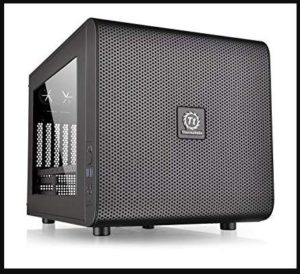
Availability is outstanding – Amazon, Newegg or even your local micro center will sell everything you need. Put it all on your credit card or pay straight cash if you want. Newegg even accepts Bitcoin or Bitcoin Cash! Overnight shipping is available for just about everything if you want it ASAP, and free shipping if you don’t. Return policies are generous and hassle-free. Warranties tend to be 3+ years, which will last the entire usable mining life of the parts. Warranty service is straightforward and the furthest you’ll ever have to send a package is to California. Again, it’s not even a contest, GPUs win hands down.
Conclusion
This all makes ASICs sound like a bad idea at best or a scam at worst, but I won’t go that far. ASICs aren’t a scam or even a bad idea. They’re just industrial machinery for large corporations with the ideal conditions to make them profitable. Are you a multi-million dollar corporation with access to megawatts of power in a location with cheap land, cheap labor, a cold climate, and loose regulations? If so, then ASICs are for you. If not, then don’t waste your time and money. Small and medium-size mining belongs to the GPU. Particularly for small miners running a few rigs in their basement, you are at a sizeable advantage against the larger competition because you don’t need a dedicated facility or massive infrastructure upgrades to run them. Don’t get me wrong – if you’re dead set on ASICs, I’ll make them work for you as best as I can, you’ll just never see me recommend one.
###########################################
bitpro started out as a company specializing in the design, building, and management of cryptocurrency mining rigs and large-scale operations. We no longer provide consulting services, but we still follow all market aspects closely, as our hardware resale business requires us to take a unique approach to the mining hardware market.
Learn more about us on our website: bitproit.com
